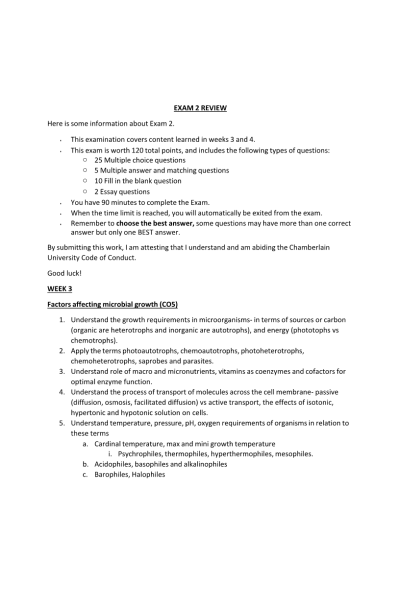BIOS 242 Week 5 EXAM 2 Review
-
$25.00
| Institution | BIOS 242 Fundamentals of Microbiology with Lab - Chamberlain |
| Contributor | Anika Fultz |
EXAM 2 REVIEW
Here is some information about Exam 2.
- This examination covers content learned in weeks 3 and 4.
- This exam is worth 120 total points, and includes the following types of questions:
- 25 Multiple choice questions
- 5 Multiple answer and matching questions
- 10 Fill in the blank question
- 2 Essay questions
- You have 90 minutes to complete the Exam.
- When the time limit is reached, you will automatically be exited from the exam.
- Remember to choose the best answer, some questions may have more than one correct answer but only one BEST answer.
By submitting this work, I am attesting that I understand and am abiding the Chamberlain University Code of Conduct.
Good luck!
WEEK 3
Factors affecting microbial growth (CO5)
- Understand the growth requirements in microorganisms- in terms of sources or carbon (organic are heterotrophs and inorganic are autotrophs), and energy (phototophs vs chemotrophs).
- Apply the terms photoautotrophs, chemoautotrophs, photoheterotrophs, chemoheterotrophs, saprobes and parasites.
- Understand role of macro and micronutrients, vitamins as coenzymes and cofactors for optimal enzyme function………. Continue
Enzymes (CO6)
- Understand metabolism, anabolism, and catabolism in terms of nutrient utilization, energy production and macromolecule building.
- Understand the role of enzyme as biological catalysts in lowering activation energy, factors of enzyme function- temperature, concentration of enzyme and substrates. ………. Continue
Metabolism (CO6)
Understand and apply the catabolism of glucose in aerobic, anaerobic and fermentation pathways………. Continue
WEEK 4
Controlling Microbial growth (CO7)
- Principle Methods of controlling growth- Compare and contrast disinfection, sterilization, sanitization and antisepsis in terms of number of microbes destroyed by each and where they are used.
- Understand the terms -cidal (e.g. bacteriocidal) and -static (e.g. bacteriostatic) in relation to different microbes
- Know the relative resistance of microbes, the most resistant microbial forms and the one used as standard of sterilization; list five principle physical and chemical ways of achieving sterilization………. Continue
Antibiotics (CO7)
- Compare and contrast Chemotherapeutic, prophylactic, synthetic and semi-synthetic drugs.
- Know the characteristics of an ideal antimicrobial agent.
- Understand and apply the terms broad and narrow spectrum drugs, know which category drugs like Isoniazid, Streptomycin (aminoglycoside), Tobramycin, Polymyxin, Tetracycline, Sulfonamide, Erythromycin, Cephalosporin, and Carbapenems belong to………. Continue
Host Microbe interaction (CO8)
- Understand the term normal/indigenous biota and opportunistic vs nosocomial infections. What factors lead to growth of these?
- Understand the method of inoculation or acquisition of normal biota is acquired, axenic environments and which body systems are axenic.
- Know the terms- infection, pathological state, disease and infectious disease, TORCH acronym………. Continue
Epidemiology (CO8)
- Understand and apply the terms- Epidemiology, Prevalence vs incidence of disease rate, mortality rate vs morbidity rate
- Compare and contrast the four types of outbreaks: epidemic, endemic, sporadic and pandemic.
- Understand the role of CDC, and relate this to the term reportable diseases
| Instituition / Term | |
| Term | Uploaded 2023 |
| Institution | BIOS 242 Fundamentals of Microbiology with Lab - Chamberlain |
| Contributor | Anika Fultz |















































